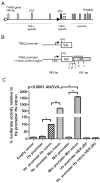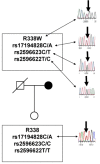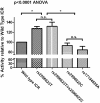An intronic SNP in the thyroid hormone receptor β gene is associated with pituitary cell-specific over-expression of a mutant thyroid hormone receptor β2 (R338W) in the index case of pituitary-selective resistance to thyroid hormone
- PMID: 21871106
- PMCID: PMC3170239
- DOI: 10.1186/1479-5876-9-144
An intronic SNP in the thyroid hormone receptor β gene is associated with pituitary cell-specific over-expression of a mutant thyroid hormone receptor β2 (R338W) in the index case of pituitary-selective resistance to thyroid hormone
Abstract
Background: The syndrome of resistance to thyroid hormone (RTH) is caused by mutations in the thyroid hormone receptor β gene (THRB). The syndrome varies from asymptomatic to diffuse hypothyroidism, to pituitary-selective resistance with predominance of hyperthyroid signs and symptoms. The wide spectrum of clinical presentation is not completely attributable to specific THRB mutations. The THRB gene encodes two main isoforms, TR β1 which is widely distributed, and TR β2, whose expression is limited to the cochlea, retina, hypothalamus, and pituitary. Recent data demonstrated that in mice an intron enhancer region plays a critical role in the pituitary expression of the β2 isoform of the receptor. We thus hypothesized that polymorphisms in the human homologous region could modulate the pituitary expression of the mutated gene contributing to the clinical presentation of RTH.
Methods: Screening and in vitro characterization of polymorphisms of the intron enhancer region of the THRB gene in the index case of pituitary-selective RTH.
Results: The index case of pituitary-selective resistance is characterized by the missense R338W exon 9 mutation in cis with two common SNPs, rs2596623T and rs2596622C, located in the intron enhancer region of the THRB gene. Reporter gene assay experiments in GH3 pituitary-derived cells indicate that rs2596623T generates an increased pituitary cell-specific activity of the TR β2 promoter suggesting that rs2596623T leads to pituitary over-expression of the mutant allele.
Conclusions: The combined coding mutation and non-coding SNP therefore generate a tissue-specific dominant-negative condition recapitulating the patient's peculiar phenotype. This case illustrates the role of regulatory regions in modifying the clinical presentation of genetic diseases.
Figures



References
-
- Sakurai A, Takeda K, Ain K, Ceccarelli P, Nakai A, Seino S, Bell GI, Refetoff S, DeGroot LJ. Generalized resistance to thyroid hormone associated with a mutation in the ligand-binding domain of the human thyroid hormone receptor beta. Proc Natl Acad Sci USA. 1989;86:8977–8981. doi: 10.1073/pnas.86.22.8977. - DOI - PMC - PubMed
-
- Chatterjee VK. Resistance to thyroid hormone--an uncommon cause of thyroxine excess and inappropriate TSH secretion. Acta Med Austriaca. 1994;21:56–60. - PubMed
-
- Refetoff S, Weiss RE, Usala SJ. The syndromes of resistance to thyroid hormone. Endocr Rev. 1993;14:348–399. - PubMed
Publication types
MeSH terms
Substances
Grants and funding
LinkOut - more resources
Full Text Sources
Other Literature Sources

